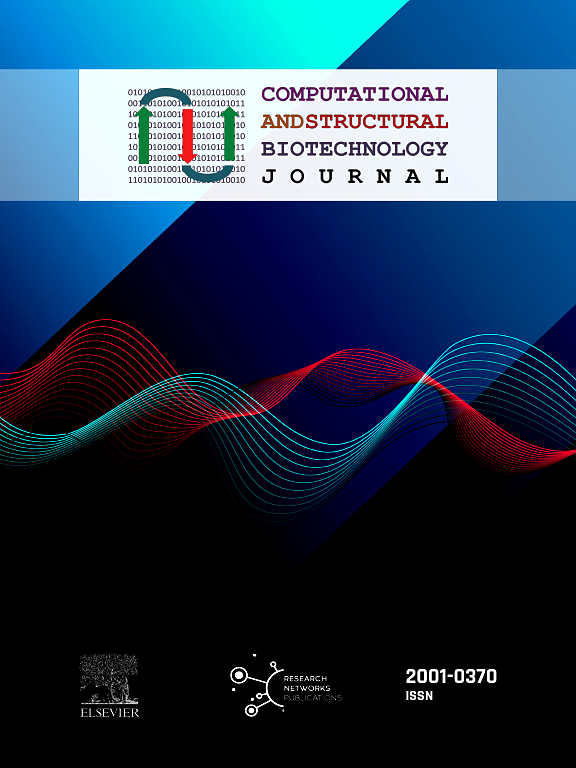Modeling the different conformations of the human mitochondrial ADP/ATP carrier using AlphaFold and molecular dynamics simulations of the protein-ligand complexes
IF 4.4
2区 生物学
Q2 BIOCHEMISTRY & MOLECULAR BIOLOGY
Computational and structural biotechnology journal
Pub Date : 2025-01-01
DOI:10.1016/j.csbj.2025.03.036
引用次数: 0
Abstract
The ADP/ATP Carrier (AAC), a member of the mitochondrial Solute Carrier Family 25 (SLC25), facilitates the exchange of cytosolic ADP for mitochondrial ATP across the inner mitochondrial membrane (IMM). It serves as a master regulator of the cellular ADP/ATP ratio and is involved in various pathologies, including cancer. Its transport mechanism involves a conformational transition that alternates the accessibility of the binding site between the cytoplasmic (c-state) and mitochondrial (m-state) sides of the IMM. In this study, the human AAC was used as a case study to evaluate the performance of AlphaFold2 (AF2) and AlphaFold3 (AF3) for structural modeling of members of the SLC25 family. The study also compared the AF3 approach for predicting protein-ligand complexes with the standard methodology of modeling followed by molecular docking. Both AF2 and AF3 display a bias toward the c-state conformation. On the other hand, ColabFold implementation of AF2 successfully generated the first ab initio structural model of the human AAC in the m-state conformation. Modeling of the complexes coupled to molecular dynamics (MD) simulations allowed to obtain structural insight into AAC’s substrate binding and stabilization mechanisms, and the possible effects of pathogenic mutations on its conformational dynamics and functionality. These analyses provided a deeper understanding of AAC’s alternating access mechanism and highlighted the potential of AF3 in modeling protein-ligand interactions, though only in the c-state. This work demonstrates the reliability of AlphaFold models when aligned with experimental data and provides further confirmation of their utility for investigating solute carriers and membrane proteins.
利用AlphaFold和蛋白质配体复合物的分子动力学模拟模拟人类线粒体ADP/ATP载体的不同构象
ADP/ATP载体(AAC)是线粒体溶质载体家族25 (SLC25)的一员,促进细胞质ADP与线粒体ATP在线粒体内膜(IMM)上的交换。它作为细胞ADP/ATP比率的主要调节器,参与包括癌症在内的各种病理。其转运机制涉及IMM的细胞质(c-态)和线粒体(m-态)之间结合位点的可及性的构象转变。在本研究中,以人类AAC为例,评估了AlphaFold2 (AF2)和AlphaFold3 (AF3)在SLC25家族成员的结构建模中的性能。该研究还比较了AF3预测蛋白质配体复合物的方法与标准的建模方法,然后进行分子对接。AF2和AF3都倾向于c态构象。另一方面,ColabFold对AF2的实现成功生成了首个m态构象的人类AAC从头算结构模型。结合分子动力学(MD)模拟对这些复合物进行建模,可以深入了解AAC的底物结合和稳定机制,以及致病突变对其构象动力学和功能的可能影响。这些分析提供了对AAC交替访问机制的更深入理解,并强调了AF3在模拟蛋白质-配体相互作用方面的潜力,尽管仅在c态。这项工作证明了AlphaFold模型与实验数据一致时的可靠性,并进一步证实了它们在研究溶质载体和膜蛋白方面的实用性。
本文章由计算机程序翻译,如有差异,请以英文原文为准。
求助全文
约1分钟内获得全文
求助全文
来源期刊

Computational and structural biotechnology journal
Biochemistry, Genetics and Molecular Biology-Biophysics
CiteScore
9.30
自引率
3.30%
发文量
540
审稿时长
6 weeks
期刊介绍:
Computational and Structural Biotechnology Journal (CSBJ) is an online gold open access journal publishing research articles and reviews after full peer review. All articles are published, without barriers to access, immediately upon acceptance. The journal places a strong emphasis on functional and mechanistic understanding of how molecular components in a biological process work together through the application of computational methods. Structural data may provide such insights, but they are not a pre-requisite for publication in the journal. Specific areas of interest include, but are not limited to:
Structure and function of proteins, nucleic acids and other macromolecules
Structure and function of multi-component complexes
Protein folding, processing and degradation
Enzymology
Computational and structural studies of plant systems
Microbial Informatics
Genomics
Proteomics
Metabolomics
Algorithms and Hypothesis in Bioinformatics
Mathematical and Theoretical Biology
Computational Chemistry and Drug Discovery
Microscopy and Molecular Imaging
Nanotechnology
Systems and Synthetic Biology
 求助内容:
求助内容: 应助结果提醒方式:
应助结果提醒方式:


